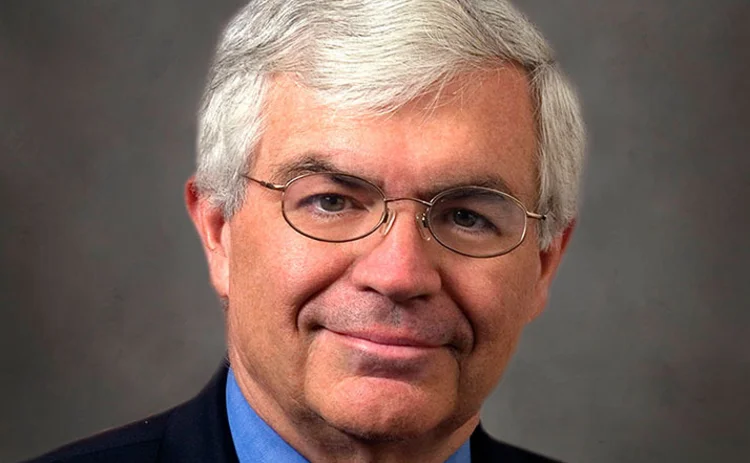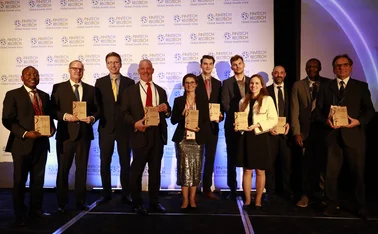
Economics in central banking: John Taylor
Stanford University professor proposes global 'rules of the game'

The global monetary system has proven an unstable place in the years after 2008. Advanced economy central banks have pumped liquidity into the system via unprecedented programmes of monetary easing, possibly averting a second Great Depression but unbalancing the system and driving violent capital flows into vulnerable economies. There were signs in 2015 that both developed and emerging markets are being affected. And, as the nature of the side effects gradually grows clear, the calls for action are getting louder.
There has been much talk around the creation of a global 'rules of the game'. But despite prominent support from G20 central bank governors with career backgrounds at the International Monetary Fund, discussions are still at an early stage. As such, John Taylor's proposals for a rules-based global equilibrium look highly prescient. In his paper – A rules-based cooperatively-managed international monetary system for the future, winner of this year's Central Banking Award for Economics – Taylor outlines proposals that do not require central banks to deviate from domestically optimal policy, and yet deliver a near-optimal outcome on the global level.
Under his specification, each country's central bank lays out transparently how it will respond to shocks to prices and output, putting it on a frontier trading off output and price variability. Taylor cites Norges Bank as an example of what this might look like – the central bank provides a detailed rationale for the factors behind each decision, including the factors it is ignoring in the short term. Unusually among central banks, it even publishes an explicit expected path for future interest rates. In 2010, Norges Bank noted its actual policy rate, 2%, was well below the 4% rate implied by its domestic rule-of-thumb, but was being forced down by low rates abroad.
In Taylor's global equilibrium, the central bank follows the rule it lays out, with some flexibility, creating certainty and stability in the process. According to his models, the choice of a policy strategy has little impact on other countries, leaving them free to set policy at the domestic optimum. It is only optimal to deviate from the rule in response to extraordinary circumstances, such as a burgeoning financial crisis.
The result seems remarkable amid all the talk of spillovers. "It is a little surprising that you do not have to adjust your policy because, say, the European Central Bank [ECB] has adjusted its policy," Taylor tells Central Banking. "But I think it is correct and I think the history and the theory says it is accurate."
Rules-based controversy
Taylor is a long-standing professor of economics at Stanford University, a former member of US President George H W Bush's Council of Economic Advisers, and a current and former adviser to many central banks. His work appears widely on economics courses, in academic work and in policy discussions at central banks. Yet his advocacy of rules-based monetary policy is frequently challenged by central bankers, who see it as a threat to their independence and their ability to respond to idiosyncratic shocks.
Some of this stems from a misunderstanding – Taylor never advocated a mechanistic reliance on rules. Other complaints may also result from political positioning. The Federal Reserve has found itself besieged in recent years by Republican politicians who favour rules-based policy. Fed chair Janet Yellen has fought back hard against Section 2 of the 'Form Act', which would require the Fed to specify a policy rule and follow it, albeit with some flexibility allowed. Yellen argues the act is a threat to the Fed's independence and a recipe for poor policy-making.
In less politically charged times, rules-based policy-making was discussed more openly. Yellen herself, while a member of the Federal Open Market Committee in 1996, gave a speech offering an endorsement of Taylor rules as a guide to setting policy, particularly under uncertainty. She pointed to the explicit nominal anchor, the rule's flexibility in balancing inflation against output, its robustness in the face of uncertainty, and its effectiveness in communicating policy simply. But she still stressed she saw it as a benchmark, not a rule to be followed strictly.
Global scale
Taylor's proposal for the international monetary system does not require a rule to be written out mathematically. "It can be stated in general terms," he says. "You would mention the instruments, say the policy interest rate, and you would mention the things you would be reacting to – you could give a range of responses. It is not mechanical." The aim is for central banks to be transparent and predictable, and not pursue policies that boost the domestic economy at the expense of foreigners.
Taylor points to the experience of the 1980s, 1990s and early 2000s as an example of a similar policy. Central banks did not go so far as to use the term 'rules-based policy', but they rarely deviated from the optimal policy as indicated by a Taylor rule. It was a period of remarkable stability, at least until 2008.
Regulators clearly failed to constrain the excesses of the banking sector in the run-up to the crisis – although some also blame loose Fed policy. Nevertheless, central banks' new-found focus on financial stability need not move them away from the price-output frontier, Taylor says. He is sceptical that central banks are well-enough informed to vary capital buffers or loan-to-value ratios over the cycle, but thinks robust and well-enforced regulatory requirements such as the Basel III framework can provide central banks room to follow a rule based on price and output stability. "Enforcement of the regulation is important as well as the regulations themselves," he says. "Lack of enforcement was a big problem going into the financial crisis."
At the optimal frontier, countries choose policy as a trade-off between variability in output and variability in prices. There is no incentive to deviate if everyone stays on the frontier, which yields a form of Nash equilibrium. The only time it is necessary to take extraordinary measures is when a crisis is developing, but Taylor says such measures would be temporary, adding he would ideally like to see crisis responses laid out at least in rough outline before problems get out of hand.
Beggar thy neighbour
The equilibrium only breaks down when countries deviate and start setting policy for reasons other than price and output stability – for instance, to devalue their currency. If a central bank cuts rates to lower than the exchange rate, this can quickly become a race to the bottom.
In the paper, Taylor suggests a similar downward race was a factor behind 2014's expansion of QE by the Bank of Japan and this year's launch of QE by the ECB. Both central banks cited the strength of their currencies as key concerns ahead of the decisions, and both currencies duly fell after the policies were launched. Similarly, although the Fed has now started to move rates up, the strong dollar is a key concern. Competitive devaluation was not the original intent of QE, but when one central bank starts, others are forced to follow, Taylor says.
Over the same period, emerging market currencies have fluctuated in the face of abundant global liquidity. Evidence compiled by the Bank for International Settlements (BIS), among others, points to QE as a major factor driving these capital movements, which rush in and out of economies. The global monetary system since 2008 is hardly a picture of stability.
Fed policy-makers, such as former chair Ben Bernanke, have argued QE benefits everyone by boosting trade demand. Taylor disagrees. Based on simulations from the IMF's multi-country monetary model 'GPM6', a Fed rate cut below the rules-based level provides a small boost to output for developed countries (Japan and Europe), but significantly reduces output in Asian and Latin American emerging markets, where the exchange rate effects outweigh the benefits. "The policy simulations do not support an enrich-thy-neighbour view," Taylor writes.
Co-operation in practice
Co-operation between central banks has been elusive in recent years, with emerging markets complaining of the scant regard paid to them when developed economies unveil ever more ambitious easing policies. Prominent voices such as Reserve Bank of India governor Raghuram Rajan and Bank of Mexico governor Agustín Carstens have called for more attention to be paid to the operation of the global system.
A major part of the appeal of Taylor's proposals is their recognition of the political reality – persuading central banks to set policy with the wellbeing of foreign economies in mind is likely to be near-impossible, but aligning optimal domestic and global outcomes seems achievable. Rajan appeared to recognise this in a speech in November, when he called for a global "rules of the game". He warned central banks "may be lapsing into policies that take growth from one another", and said he was not asking for "co-ordinated action, just collective".
Taylor believes central bankers could be persuaded. "There is a general sense of central bankers wanting to be predictable and not surprise the market," he says. "The idea that they should be predictable, rules-based, systematic, is not an unusual way for central bankers to be. And the notion we can do QE whenever we want is not viewed so positively now."
There would need to be a transitional period, where countries normalise their policies and eliminate current divergence – no small task, but Taylor points to Bretton Woods to show it has been done before. After that, central banks would lay out their domestic rules. The BIS or IMF could provide a valuable forum for central banks to work towards this end, and staff at these international organisations could monitor central bank strategies. Leadership from major central banks, such as the Fed, could also smooth the way, Taylor says.
Monetary co-operation alone may not be enough to fix the ills of the international monetary system, Taylor notes – it may not even be the most important part of reforms. But "it has the key prerequisites of a good, feasible reform: each country can choose its own independent strategy, avoid interfering with the principles of free and open markets, and contribute to the common good of global stability and growth".
The Central Banking awards were written by Christopher Jeffery, Tristan Carlyle, Daniel Hinge, Arvid Ahlund, Dan Hardie and Rachael King.
Only users who have a paid subscription or are part of a corporate subscription are able to print or copy content.
To access these options, along with all other subscription benefits, please contact info@centralbanking.com or view our subscription options here: http://subscriptions.centralbanking.com/subscribe
You are currently unable to print this content. Please contact info@centralbanking.com to find out more.
You are currently unable to copy this content. Please contact info@centralbanking.com to find out more.
Copyright Infopro Digital Limited. All rights reserved.
As outlined in our terms and conditions, https://www.infopro-digital.com/terms-and-conditions/subscriptions/ (point 2.4), printing is limited to a single copy.
If you would like to purchase additional rights please email info@centralbanking.com
Copyright Infopro Digital Limited. All rights reserved.
You may share this content using our article tools. As outlined in our terms and conditions, https://www.infopro-digital.com/terms-and-conditions/subscriptions/ (clause 2.4), an Authorised User may only make one copy of the materials for their own personal use. You must also comply with the restrictions in clause 2.5.
If you would like to purchase additional rights please email info@centralbanking.com







